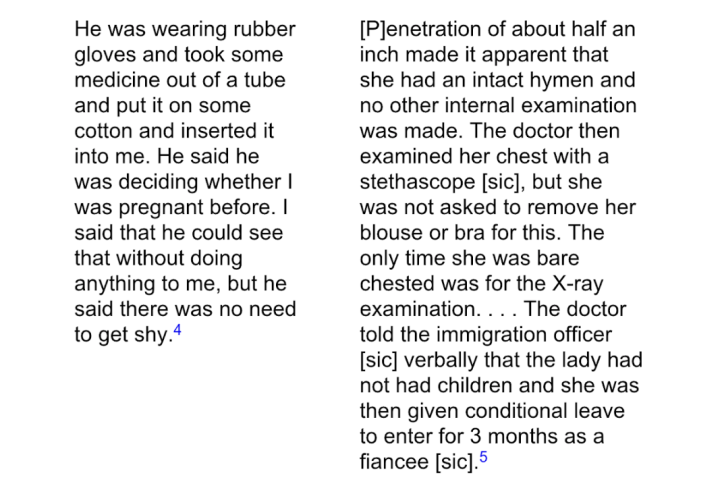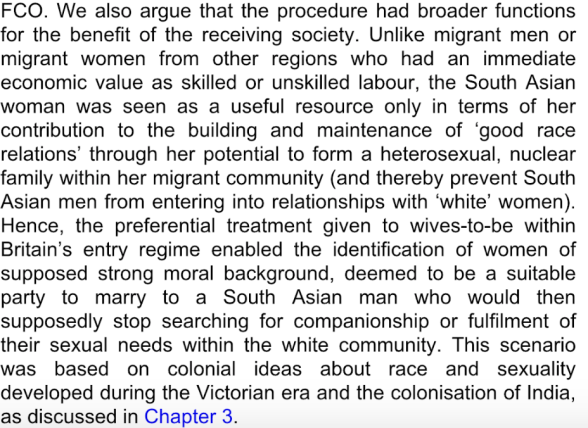1970s Britain for South Asian immigrant women reflects a dark and institutionally racist past. Britain held a secret. One that the Home Office attempted to conceal until an article written by a Guardian journalist named Melanie Phillips disclosed information about illicit immigration practices during the late 1970s. In her article titled ‘virginity tests on immigrants at Heathrow’ – published on the first of February in 1979, Melanie exposed the Home Office for conducting virginity tests on Indian women at Britain’s national and international borders.
This only came to light when a 35-year-old Indian woman arrived at Heathrow airport in London on January 24th 1979. She arrived to the UK in preparation for marriage to her fiancé – a British Indian citizen. Unknown to her, once in the UK, she would be subjected to an evasive and humiliating gynaecological examination. A virginity test.
 Photograph: Guardian
Photograph: Guardian
The immigration officer who issued the examination was of the opinion that her ‘engagement status was not in line with her age’ therefore concluding that she had already been married. It was on this basis that the immigration officer informed the doctor to conduct the virginity test in an attempt to determine whether or not she had previously had any children. The doctor performing the test was a male.
Below is a copy of two statements. The first statement on the left was given by the Indian women interviewed by The Guardian. She discloses to the journalist what happened to her on 24 January 1979 – this was then published in Phillips article the following month. The second statement on the right, is the doctors recollection of the occurrence. Two very different experiences.

Testimony: Smith & Marmo, 2014, p.3
Imagine being in a new country, thousands of miles away from home, all by yourself – and then, imagine being subjected to that level of humiliation. Imagine that being your first encounter as a migrant to the UK. Imagine that being your first encounter as a virgin. Imagine power and politics being used to exert ownership over your own body. Imagine your body being used by the colonialist, (in a supposedly post-colonial Britain) to exercise a white hegemonic privilege – by reducing your body to flesh, bones and a test sheet. All of this, just because these women were brown women. The extent to which institutionalised racism had travelled was evidential.
In their study of these proceedings, academics Smith and Marmo disclose how despite this happening, the home office publicly declared that no such ‘internal vaginal examination’ had taken place.
“there was no internal examination and that [the medical officer] very quickly and decently established that she was virgo intacto” (Smith & Marmo, 2014, p.4).
The statement in itself was an absolute outrage and a lie. On the contrary to what the home office had stated, absolutely nothing was ‘decently established’ by conducting virginity tests. These ‘tests’ were being conducted on Indian women, and this was the first such case that had brought this to light revealing that there had been many others. Had this woman not retaliated by speaking out, we may never have known of the horrors of past immigration policies in this country. The deliberate violation of brown female bodies was purposefully and systemically in place to ensure the examining of the ‘trustworthy’ immigrant. It was how the government was able to exert a more policed and controlled approach to othering these women, thereby giving this heinous act of racism a false sense of credibility.
So why exactly were virginity tests being conducted and what do they tell us about Britain’s attitudes towards female bodies that were not white?
The British legal regime in the 1970s had an immigration policy in place that stated anyone entering Britain to marry their fiancé or fiancée within 3 months of arriving did not need a visa or entry clearance. Despite this policy, it was only at the borders in India or at Heathrow airport in the UK, that Indian women became aware of just how they were expected to prove their authenticity as migrant women looking to start married life in Britain (Smith & Marmo, 2014, p.2). To prove that you were not a liar trying to seek refuge in this country and was in fact here to start married life, you were told that your virginity needed to be tested. Consequently, brown women were met at the borders by a white man in a white coat (more often than not) who had been given the autonomy to determine just how ‘pure’ and honest these women really were. And the testing did not end there.
It was not just unmarried women who were being tested on, there were children too, girls said to be younger than 16 years of age (Smith & Marmo, 2014, 2). Married women were also no exemption as we saw with the high-profile case of Birmingham born Anwar Ditta in 1979. Anwar was informed by the Home Office that she was not allowed to bring her 3 Pakistan-born children to the UK where she lived in Rochdale with her husband. Anwar had lied about her age when she married her husband under Islamic practice in Pakistan because she was only 15 years old at the time. When Anwar moved back to the UK with her husband they married again under British Law. However, the immigration office was of the opinion that there were two Anwar Ditta’s and that her children were someone else’s. The government used the discrepancy with her age as the reason for keeping her children away.

“The Home Office’s decision left Anwar Ditta in despair. She had photographs of herself in Pakistan with her husband, her family and with her children (see images). She had birth certificates for all her children and, despite having asthma in England as a child and needing frequent medical attention, there were no medical records for her in Britain for 13 years until she re-registered in 1975. None of this evidence was accepted. Her father declared in an affidavit that he had sent  Anwar at the age of nine with her sister Hameeda to Pakistan. Hameeda also acted as a witness to Anwar’s life in Pakistan and witnessed the birth of Anwar’s first child. When Anwar’s fourth child was born in Rochdale, the hospital confirmed that this was her fourth pregnancy. Despite the evidence collected to support Anwar’s story, the Home Office maintained a suggestion that Anwar’s children actually belonged to her sister-in-law.”
Anwar at the age of nine with her sister Hameeda to Pakistan. Hameeda also acted as a witness to Anwar’s life in Pakistan and witnessed the birth of Anwar’s first child. When Anwar’s fourth child was born in Rochdale, the hospital confirmed that this was her fourth pregnancy. Despite the evidence collected to support Anwar’s story, the Home Office maintained a suggestion that Anwar’s children actually belonged to her sister-in-law.”
Extract and Image: www.ourmigrationstory.org
In November of 1979, Anwar approached the Manchester based lawyer Steve Cohen who had worked on cases similar to hers previously. Together they fought the case for her children holding a public meeting in Rochdale which began the Anwar Ditta Defence campaign. Support for Anwar came far and wide with 3,000 signatures handed to the then Minister, Timothy Raison, responsible for immigration at Manchester Town Hall.
 Image: archiveplus.org
Image: archiveplus.org
Given the high-profile nature of Anwar’s case and increasing public pressure both nationally and internationally, blood tests were conducted to eventually prove that Anwar was the mother of these three children. Furthermore, to validate this truth, Anwar was also subjected to a virginity test which she described in an interview to the BBC in 1999 as ‘abuse by consent’. Evidently her six-year-long activism, testimonies and blood tests were not sufficing. Validation through a virginity test was apparently deemed crucial by the home office in the case of Anwar Ditta.
In a thought-provoking and particularly revealing reading of the virginity test scandal, Smith and Marmo unpack in their work through a much-needed nuanced debate on why brown women were being exploited by the UK government in the way that they were.
 Extract: Smith & Marmo, 2014, p.4
Extract: Smith & Marmo, 2014, p.4
According to Smith and Marmo’s study in this the practise of virginity testing began in 1968 and ended in 1979 – this went on for eleven years. What’s more disturbing is the devotion given to hiding this from the public. A majority of the available data of this practise (whilst limited) was held at the British High Commission in South Asia. This was an attempt to keep the practise of virginity testing hidden from the public.
Thirty years were taken for the two researchers to gain access to the information and the details of what had happened to these women. Not only does this point to how the government has a history of evading responsibility and culpability for its actions – as we have seen with Grenfell, it also reminds us, that where there is power and privilege, ‘there are those who govern, and those who are governed’ (Smith & Marmo, 2014, p.2).
Anwar Ditta’s story was first told in the documentary ‘Playing the Race Card’, the first of a three-part series aired on BBC2 on 24th October 1999 at 7.10pm
Book: E. Smith, M. Marmo (2014). Race, Gender and the Body in British Immigration Control: Subject to Examination. London: Palgrave Macmillan. p. 1-5.

That’s horrible, I can’t even believe they would want to conduct such a test. Who even cares if a woman is a virgin? Yes, I know many religions see it as important, but still. Private lives aren’t the concern of border control.
LikeLiked by 1 person